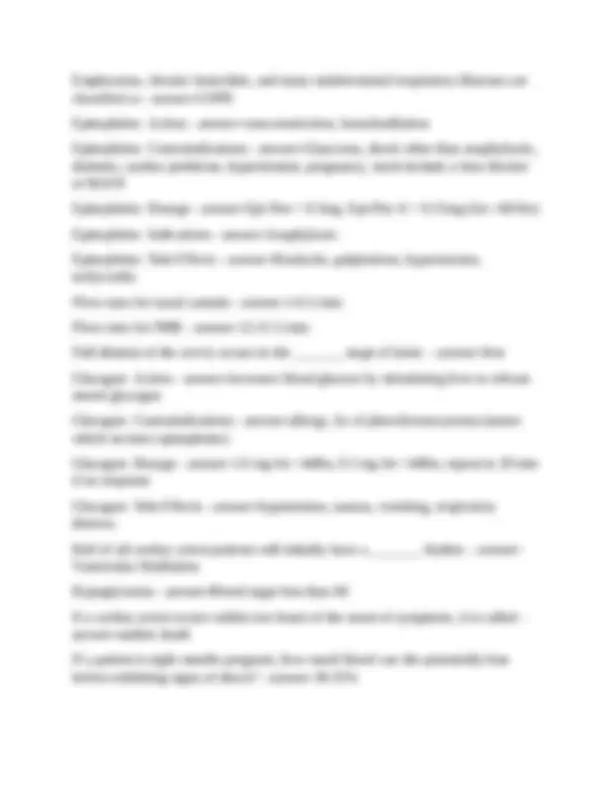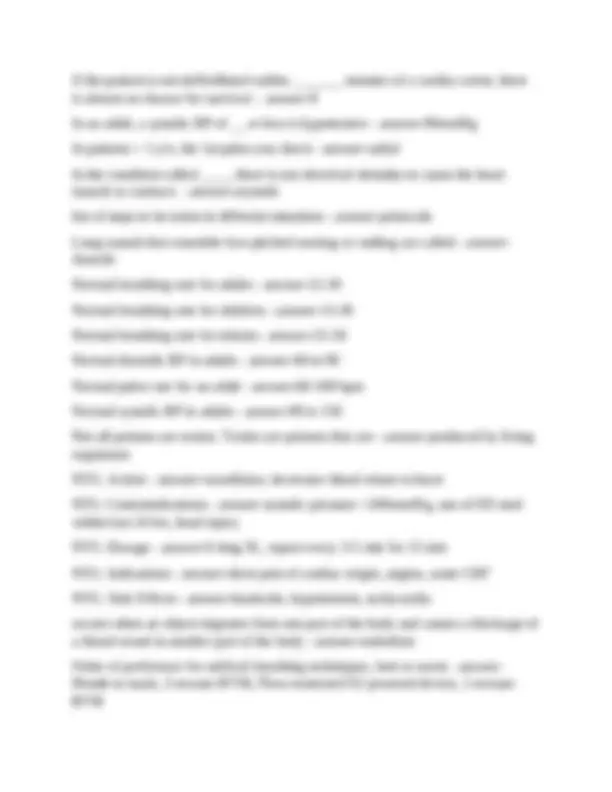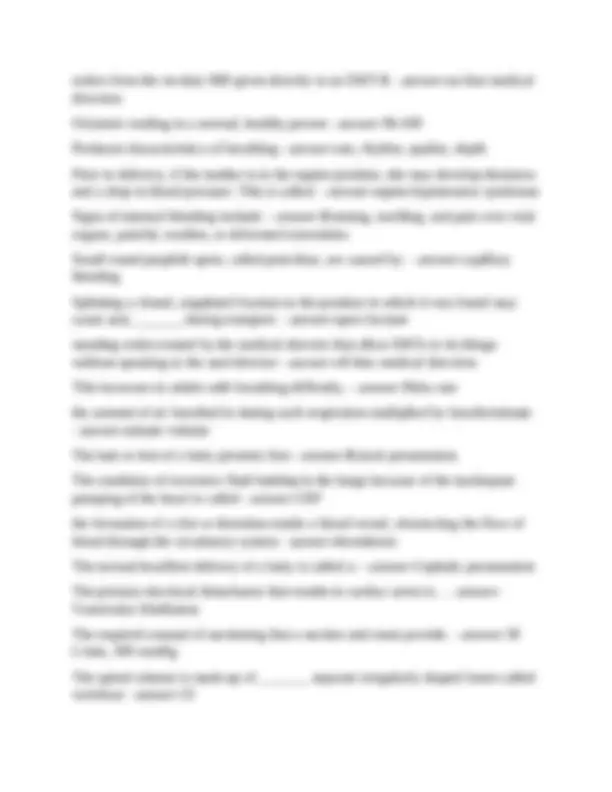





Study with the several resources on Docsity

Earn points by helping other students or get them with a premium plan


Prepare for your exams
Study with the several resources on Docsity

Earn points to download
Earn points by helping other students or get them with a premium plan
Community
Ask the community for help and clear up your study doubts
Discover the best universities in your country according to Docsity users
Free resources
Download our free guides on studying techniques, anxiety management strategies, and thesis advice from Docsity tutors
A comprehensive overview of the key topics and concepts covered in the emt national registry exam. It covers a wide range of subjects, including vital signs, respiratory conditions, medication administration, cardiac emergencies, and more. The detailed information and practice questions make this document a valuable resource for emt students and professionals preparing for the exam. Essential knowledge and skills required for emergency medical technicians, including recognizing and managing various medical emergencies, administering appropriate treatments, and following established protocols. By studying this document, readers can gain a deeper understanding of the exam content, identify areas for improvement, and develop the necessary competencies to excel in the emt national registry exam.
Typology: Exams
1 / 6

This page cannot be seen from the preview
Don't miss anything!




3 effects of intracranial pressure on vital signs - answer-bradycardia, irregular breathing, hypertension ___ ___ is part of a syndrome called chronic obstructive pulmonary disease (COPD) - answer-chronic bronchitis ___ ___ is usually caused by viruses or bacteria and may last several days or weeks. - answer-Acute bronchitis a group of diseases characterized by the pathological limitation of airflow in the airway that is not fully reversible. - answer-COPD A late sign of shock is: - answer-decreased blood pressure A PASG is contraindicated if the patient presents with cardiogenic shock or _______. - answer-abnormal lung sounds a policy or protocol issued by a medical director that authorizes EMTs to perform particular skills in certain situations - answer-standing orders A sign of breathing difficulty in children is a decrease in ___ ___. - answer-pulse rate A sudden loss of _______ of blood is considered serious in an average adult. - answer-1000cc A thrombus which has broken loose, moving with blood flow, is called - answer-an embolism A weakened section of an arterial wall that begins to dilate is known as a(n) - answer-aneurysm Activated Charcoal: Contraindications - answer-Poor LOC, vomiting Activated Charcoal: Dosage - answer-1 g/kg of body weight, adults usually 25- 50g, children 12.5-25g Activated Charcoal: Side Effects - answer-Constipation, nausea, vomiting, bowel obstruction
After delivering your first shock with an AED, the patient is still pulseless, you should next - answer-perform two minutes or 5 cycles of CPR Albuterol: Action - answer-Bronchodilator Albuterol: Contraindications - answer-Allergy Albuterol: Dose - answer-2.5 mg nebulized with 2.5 mL saline (for a total of 3mL) Albuterol: Indications - answer-Acute bronchospasm due to asthma or COPD Albuterol: Side effects - answer-Headache, tachycardia, hypertension An example of a shockable rhythm - answer-pulseless ventricular tachycardia An infant or child patient who exhibits wheezing, increased breathing effort on exhalation, or rapid breathing without stridor probably has: - answer-A lower- airway disease an inflammation of the bronchi (medium-size airways) in the lungs - answer- bronchitis ASA: Action - answer-Impedes blood clotting ASA: Contraindications - answer-allergy, bleeding disorder, already taken 324mg ASA: Dosage - answer-324mg (81mg x 4) Atrovent: Action - answer-Bronchodilator Atrovent: Contraindications - answer-Allergy to drug, soybeans, peanuts, glaucoma Atrovent: Dose - answer-0.5 mg nebulized w/ 2.5 mL saline (3mL total) Atrovent: Side Effects - answer-Dry mouth, headache, gastrointestinal distress caused by loss of elasticity of the lung tissue, from destruction of structures supporting the alveoli, and destruction of capillaries feeding the alveoli. - answer- emphysema Chaotic electrical activity originating from many sites in the heart is called: - answer-Ventricular fibrillation DCAP-BTLS = - answer-deformities, contusions, abrasions, punctures, burns, tenderness, lacerations, swelling
If the patient is not defibrillated within _______ minutes of a cardiac arrest, there is almost no chance for survival. - answer- In an adult, a systolic BP of __ or less is hypotensive - answer-90mmHg In patients > 1 y/o, the 1st pulse you check - answer-radial In the condition called ____, there is not electrical stimulus to cause the heart muscle to contract. - answer-asystole list of steps to be taken in different situations - answer-protocols Lung sounds that resemble low-pitched snoring or rattling are called - answer- rhonchi Normal breathing rate for adults - answer-12- Normal breathing rate for children - answer-15- Normal breathing rate for infants - answer-25- Normal diastolic BP in adults - answer-60 to 90 Normal pulse rate for an adult - answer-60-100 bpm Normal systolic BP in adults - answer-90 to 150 Not all poisons are toxins. Toxins are poisons that are - answer-produced by living organisms NTG: Action - answer-vasodilator, decreases blood return to heart NTG: Contraindications - answer-systolic pressure <100mm/Hg, use of ED med within last 24 hrs, head injury NTG: Dosage - answer-0.4mg SL, repeat every 3-5 min for 15 min NTG: Indications - answer-chest pain of cardiac origin, angina, acute CHF NTG: Side Effects - answer-headache, hypotension, tachycardia occurs when an object migrates from one part of the body and causes a blockage of a blood vessel in another part of the body - answer-embolism Order of preference for artifical breathing techniques, best to worst - answer- Mouth to mask, 2-rescuer BVM, Flow-restricted O2 powered device, 1-rescuer BVM
orders from the on-duty MD given directly to an EMT-B - answer-on-line medical direction Oximeter reading in a normal, healthy person - answer-96- Pertinant characteristics of breathing - answer-rate, rhythm, quality, depth Prior to delivery, if the mother is in the supine position, she may develop dizziness and a drop in blood pressure. This is called: - answer-supine hypotensive syndrome Signs of internal bleeding include: - answer-Bruising, swelling, and pain over vital organs; painful, swollen, or deformed extremities Small round purplish spots, called petechiae, are caused by: - answer-capillary bleeding Splinting a closed, angulated fracture in the position in which it was found may cause a(n) _______ during transport. - answer-open fracture standing orders issued by the medical director that allow EMTs to do things without speaking to the med director - answer-off-line medical direction This increases in adults with breathing difficulty. - answer-Pulse rate the amount of air breathed in during each respiration multiplied by breaths/minute